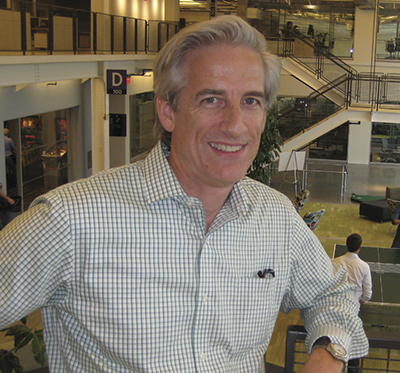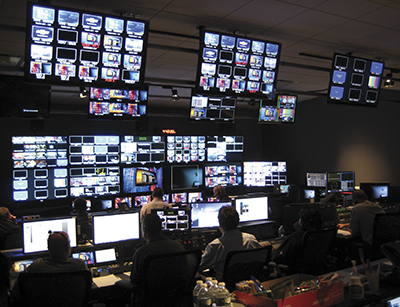NBC Opens State-of-The-Art Sports HQ

NBC built its new sports facility in a former beauty product manufacturing plant.
STAMFORD, CONN.—NBC has taken its sports pedigree to heart in the design and implementation of its new NBC Sports headquarters here. The network assembled a team of its best and brightest and gave them the Herculean task of designing and building a new facility in less than two years, all while planning and covering the London Olympics during the project. The original goal was to consolidate two local facilities, bringing local Comcast and NBC Sports together under one roof. The plan eventually grew to encompass bringing nearly all of the NBC Sports organization under one roof.
And it is no small roof. NBC worked a deal with the state to bring its project there and located it in an old Clairol plant just off I-95. In a complex consisting of an administrative building and an adjoining manufacturing plant, NBC stripped most of the two buildings down to their core structure and began work on what would eventually be a facility with more than 300,000 square feet of office and studio space.
NBC came to the game prepared with a team of technical and logistics experts who every two years produce the Olympics broadcasts. This gave them an advantage, bringing the skills necessary to manage a fast-paced project and use systems and designs that had been proven in the field many times over.
The story of how the whole project came together is a study in how, much like in sport, amazing results are possible when you bring together the right team of experienced players and coaches.
A PAGE FROM THE PLAYBOOK
“The fall of 2011 was the craziest time for us,” said Dave Mazza, NBC senior vice president and chief technology officer for NBC Sports Group and NBC Olympics. Mazza, along with Paul Koopman, vice president of engineering for NBC Sports, built and led the team from beginning to end. Their team, along with Mancini & Duffy Architects, did both the floor plan and systems design while at the same time having to get ready to leave for London in the spring. They leveraged their many years designing and building remote broadcast facilities for sports coverage around the world to create a plan, all the while juggling the demands of simultaneously covering the Olympics. “We weren’t working seven days a week, but we were working long days, often until 10 o’clock each night,” Mazza said.
The project began with a very detailed 250-page request for proposal that they created for the systems integration portion of the build. “The tighter the document is, the less change orders you are going to have,” Mazza said. They issued the RFP in early December 2011 and by late January, awarded the project to Sony and Diversified Systems of Kenilworth, N.J. They put the construction portion out to bid during the same period.
While the majority of his team was working on the project, Mazza had a portion of his Olympics team working on the design of the 2012 London broadcast center. “These guys had done this many times before, so they were familiar with what had to be done,” he said. The ability to take previous event designs and tailor them to the new venue was a major time saver for the group. “We also had the advantage of James Lee from Gensler—who specializes in fast track broadcast plant builds—as project manager.”

Dave Mazza, NBC senior vice president and chief technology officer for NBC Sports Group and NBC Olympics. The heaviest part of the construction phase occurred when the NBC team headed off to London for the summer, which enabled Paul Koopman, vice president of engineering for NBC Sports, who stayed behind, to continue the prep work with the system integrators and building crews back in Stamford. “The day we came back from London, we jumped right back into this,” Mazza said.
GAME TIME
Mazza explained that most of the project delays happened during the construction phase. Refurbishing the old beauty products plant ran into challenges in getting all the broadcast plumbing necessary for power and wiring. Instead of going the standard general contractor route, NBC chose the construction management firm of Pavarini in Stamford. “With a GC you have to have all your plans done in advance, we were making some of the plans up as we were going along,” said Mazza. Using the CM gave them more flexibility to make changes and alterations to their plans as they evolved.
Because broadcast power, lighting, HVAC and UPS systems have very specific needs, NBC went with AMA Consulting Engineers to manage the plant’s electrical and cooling needs. In the 200,000-square-foot, seven-studio production building, AMA provided guidance on choosing the critical redundant infrastructure to support among other things, an equipment core with 400 racks. Here, video racks receive 1,500 W power drops while server racks receive 4,500 W of power per rack. This all begins with two separate incoming utility feeds, with a backup of three generators feeding four UPS systems providing conditioned power to all critical infrastructure.
To handle the huge amount of data bandwidth required to support the plant, NBC worked deals with four telco operators to place points of presence within the facility. This eliminated last mile costs, and provided multiple redundant points of connectivity to 30 Rock, the Internet and other NBC facilities. They installed four JPEG 2000 bidirectional video service lines and a 10 Gig data connection with NBC headquarters at 30 Rock and with the Englewood Cliffs Network Operations Center in New Jersey. The facility’s internal data infrastructure is impressive and is based around an aisle full of Cisco Nexus 7000 routers. Like everything about the plant, there are always plans for future overhead and expansion needs.
One of the biggest time savers for the project was the ability to use proven system designs that had worked for other facilities and at the Olympics. From studio and edit layouts taken from 30 Rock and their previous facilities, to a broadcast operations center that was modeled after the International Broadcast Center design from the Olympics, Mazza’s team made good use of systems and designs that they were familiar with.

NBC Sports contracted with Sony and Diversified Systems Inc. to build the new facility. Budgeting and procurement for the equipment was orchestrated by Larry Thaler of Positive Flux and by Rob Sanders of NBC Sourcing.
Mazza’s oversight of Olympic projects also provided another synergy when it came to equipment choices. They basically designed much of the plant around the equipment they knew was coming back after the Olympics. This allowed them to slide in already configured camera, switcher and audio systems into rooms that were pre-wired and ready to receive the equipment. It also saved about 40 percent of equipment capital, according to Mazza.
NBC Sports uses much of the same equipment for all of its projects, with some exceptions for the Olympics. The switchers, cameras and monitors are all Sony, and audio boards and distribution are always Calrec. The systems that differ are the routing and terminal gear. The sports group used Evertz routers and terminal gear for their new plant, but PESA routers and Miranda terminal gear for the Olympics.
TEAM EFFORT
Beyond the impressive infrastructure of the plant was the attention paid to creating a sports oriented and collaborative work environment.
“Collaboration was part of the inspiration for this facility,” Mazza said. “There is something to be said for having everyone under one roof.” Whether for creative or technical projects, the NBC Sports broadcast plant is laid out to maximize the proximity of collaborators.
Upon entering the building you first walk by the facilities help desk, followed by rows of IT support desks, and finally the maintenance engineering staff, before ever getting to a single studio or machine. Mazza’s goal was to put the technical service folks that were traditionally tucked away in the back of building right up front. This allows personnel to check in on the status of a repair or report an issue as they enter and exit the building.
The graphics department is set up like a virtual production line, with creative management offices feeding adjacent craft editors who then hand off finished products to “versioners,” who take approved graphics and create the final versions of the product for the various outlet needs.
Multiple groups have benefited by the consolidation of so many staff into one building. NBC Sports had for many years worked with multiple far flung offices, which led to a slowdown in communications even within single groups. By bringing everyone into one facility, the goal is to open new channels of communications and foster teamwork among all groups. Mazza notes that he and his group as a whole take advantage of the ease of contact in the halls and commissary with people who need to communicate with one another on a daily basis.
The sports theme is evident everywhere inside the building. From the facility’s internal design that resembles a sports stadium, with wide hallways and stadium style signage and food court, to the glassen closed leisure space of the building with its game rooms, couches and sport memorabilia. “We tried to keep the spaces fun and informal,” Mazza said about the brightly lit mezzanine configuration at the front of the facility.
Part of the goal for the sports-themed structure was not only to inspire existing workers, but attract future ones. With the facility located nearly an hour outside Manhattan, they wanted to make sure they could offer an enticement to those who might have to make the commute out of the city or surrounding burroughs.
The Technology Behind the Facility
Routers: Two Evertz 1152 x 1152 core, One 256 x 256 Transmission and QC, 200 x 200 DUB (3 Gig-capable routers and 3 Gig peripherals)
Switchers, Cameras & Monitors: Sony (from the Olympics)
Audio: Calrec audio boards using the Hydra2 audio routing system
Editing: 60 edit rooms, mostly Avid, a few FCPs and one legacy Sony 9100 On-Line suite; Three work groups, a total of 22 Avid Isis engines and 20 channels of Airspeed
Storage: Harmonic’s Spectrum MediaDecks for ingest, 40 ingest channels and 300TB MediaGrid; One of nearly every SD and HD deck ever made for the dub room; XSAN for Macs, Graphics and FCP work stations
MAM: Avid MAM (Blue Order)
Graphics: Chyron and Mac Graphic workstations
Archive: Spectra Logic Tape Robot
Get the TV Tech Newsletter
The professional video industry's #1 source for news, trends and product and tech information. Sign up below.

